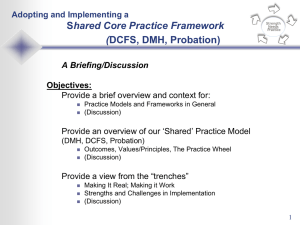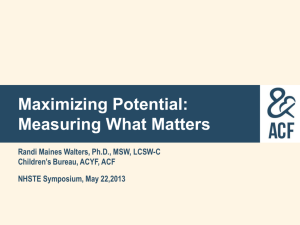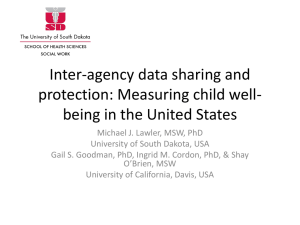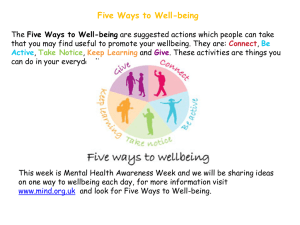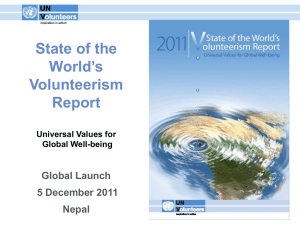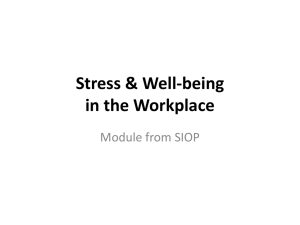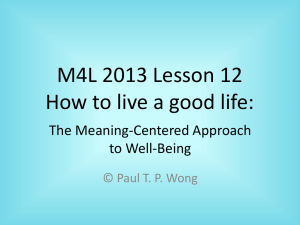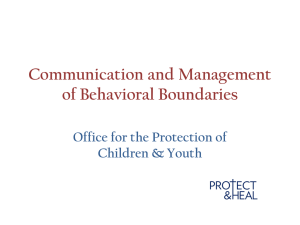Patricia Rideout Presentation (May 2013)
advertisement
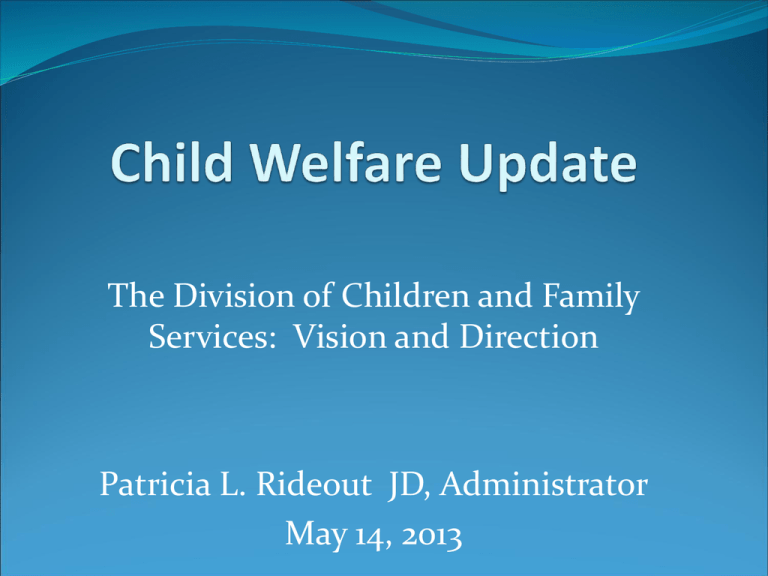
The Division of Children and Family Services: Vision and Direction Patricia L. Rideout JD, Administrator May 14, 2013 Mission The purpose of the Cuyahoga County Division of Children and Family Services is to assure that children at risk of abuse or neglect are protected and nurtured within a family and with the support of the community. Family to Family Core Principles A child’s safety is paramount Children belong in families Families need strong communities Public child welfare systems need partnerships with the community and with other systems to achieve strong outcomes for children Vision of CCDCFS We will improve the lives of children as a result of our attention, care and support. What we do… Receive and investigate referrals of abuse/neglect 23,539 calls , 15,578 calls screened in for investigation (2012) Provide ongoing services to strengthen families – while children are at home (75%) or in care (25%) Current caseloads: Ave. # of new investigations per month= 13.5, Ave. Ongoing caseload= 15.1 Provide adoption services if children can’t be reunified or placed in alternative permanent family settings 155 Adoptive placements and 137 Adoption Finalizations (2012) Provide independent living preparation 465 youth served, 15 youth aged out per mo.(2012) Workflow Diagram 6 Who we are…DCFS organization chart DCFS Strategic Planning Process Our last agency plan was in 2009 While waiting to secure a consultant, engaged in “Early Strategic Planning” Now developing a formal 3 year plan with the help of JRS Associates Plan to finalize this summer Plan will reflect our continuing commitment to a practice model based on Family to Family Today’s presentation: an informal report on recent/current efforts An Overview of Our Vision, Based on Cornerstones of Our Work Safety Permanency Well being For each of 3 cornerstones… What are some of the key indicators? What are some of the strategic initiatives we’re doing/planning 1. Safety Key Indicators include: ◦ Repeat referrals, repeat substantiations, re- opening of cases, re-entries into care ◦ Incidents while children in care ◦ High level goals: increase quality of investigations and Team Decisionmaking process 1. Safety: Strategic Initiatives Include Investigations backlog cleanup: over 94% (1,068) of overdue investigations were cleaned up between Oct. 2011April 2012 Investigative Consultants (retired detectives) ECMH Coordinator onsite Improved Team Decision Making model fidelity: eg Family Facilitator approach Supported Visits Initiative Trauma Focused Interventions (Defending Childhood) Child Advocacy Center Enhancement of Support Services unit ◦ New clinical consultation arm Cont’d Crisis intervention for parent-teen conflict: Assessment pilot Plans for use of Applewood Academy for Youth Continued discussions w/ Court, ADAMHS, DD re: more effective response than Intent to Grant process Creation of Multi System Youth unit within Case Review Supported Visits initiative: to ensure quality parent education in context of better parent-child visits Revision of Minor Parents protocols Human Trafficking: enhanced screening protocols and staff training 2. Permanency Key indicators include: Length of stay in out of home care/time to reunification, adoption or guardianship Stable reunification Permanent family connections for youth who ‘age out’ without reunification/other family Permanency: Strategic Initiatives Include: Family Tree Initiative to ensure early ID Family Search and Engagement: enhancing our own staff skills; Family Finding via TVN; Accurint software Child Centered Recruitment: enhancing our own staff skills; 5 Wendy’s Wonderful Kids recruiters Deep analysis of cases of our longest stayers Visits project: to ensure every child in care has at least a weekly visit w/ parents and siblings Continued… Partners for Forever Families (PFFF): federal “diligent recruitment” grant with many strategies, including Karamu play and Ambassador Program Residential Reviews process Development of clinical consultation arm in our Support Services area 3. Well-Being Newest focus and least defined/mandated/regulated Ensuring safety and achieving permanency are necessary but not sufficient to well- being Research: Adverse effects of maltreatment are concentrated in behavioral, social, and emotional domains Negative impacts across lifespan Direct tie to current efforts to make all our work “trauma-informed” Recommended federal strategies include: Re-think our most commonly provided services: counseling, parenting classes, and life skills training Use functional assessment: assess multiple aspects of child’s social-emotional functioning, using developmentally appropriate tools, including trauma screening Better use available assessment tools for parents too Federal recs, cont’d. Develop capacity to integrate new research, implement new practices without compromising ongoing efforts Use interventions that are known to be effective or have promising results (TFCBT, MST, PCIT—all available here) De-scale programs that aren’t showing results; shift resources to proven or promising practices Workforce development, training for partners outside child welfare; engage judiciary and courts Well-being, continued Key indicators based on well-being framework: 1. Cognitive functioning: eg school success, employment readiness 2. Physical health 3. Behavioral/emotional functioning: mental health issues, reliance on psychotropic meds 4. Social functioning: healthy relationships, IL skills Well-being: Strategic Initiatives Include: Outcome Referrals initiative: to assess impact of out of home care and lead to outcome-focused contracting for board and care; pilot underway Development of automated placement matching and monitoring system to ensure better fit for each child (RFP underway) Establishment of DCFS Resource Specialists in 31 different specialty areas Older Youth programming ◦ Monthly director’s meeting: establishment of agency youth ◦ ◦ ◦ ◦ ◦ coordination council; external assessment of older youth programming by NRCYD, summer 2013 TAG (Teen Advocate Group) Independent Living life skills education Connecting the Dots partnership with Workforce Investment Act (WIA), including summer employment program, and Big Brothers Big Sisters volunteer mentor program with a goal of 125 youth/mentor matches over the next 3 years Family search and engagement strategies to assure permanent family connections Mentoring- 28 youth are currently matched with a Permanency Champion through Adoption Network Cleveland Well-being initiatives, cont’d. Juvenile Court collaboration efforts: Crossover Youth Initiative Continued discussions of mandated custody cases CASA? Health care for foster children: In place soon: Health Care Coordinator Contract for 2d opinions on psychotropic meds Care coordination partnership w/ Metro Health Staff re-education on chronic child health issues such as asthma and diabetes Well-being initiatives, cont’d. Improved services and supports: Differential Response: target October 2014 Overhaul of our Semi Annual Review process Continuing p’ship with ADAHMHS Board, including clinicians at TDM meetings Well-being initiatives, cont’d. Educational improvements Strengthening partnerships w/ CMSD and inner ring districts Much more to do here Homelessness prevention: Partnership with IIC/others on NEST vision, to support child welfare families at risk of or experiencing homelessness Older youth: discussions with Jim Casey Youth Opportunities Initiative Well-being initiatives, cont’d. Race equity: disproportionality in placement and outcomes; links to poverty ◦ Consultant guiding revival of agency work group, to engage community next ◦ Presentations on NIS-R research and other developments in this area, last fall, in p’ship w/ CWRU Workplace Culture We must ensure an environment that supports staff and motivates them to engage in initiatives Doing more with less despite challenges: less staff/workload impacts (loss of transportation unit, START Advocates, etc) no pay increases for NBU Putting Tools in Staff’s Hands New worker classes, have filled 92 vacancies since May 2012, 12 in class now; plans to conduct quarterly hiring/training of SWs Performance Management Unit ◦ Leadership around self evaluation, quality improvement, County- and AgencyStat New clinical consultation arm of Support Services Technology ◦ New phones, blackberries, tablets, Accurint Tools for Staff, cont’d. Functional Workload Analysis: partnership w/ FCCS and PCSAO to establish workload recs; early results any day Strategic Planning with broad staff input New transportation unit to serve county foster and kin homes and ensure weekly visits Increased Visits Initiative: weekly visit expectations of network providers via board and care contracts More tools for staff External partnerships and efforts ◦ 14 Community Collaboratives ◦ Improved public system relationships ◦ Universities and Foundations (eg Schubert Center cosponsorships; Annie E. Casey Foundation, Casey Family Programs, local foundations) ◦ Positive Media: Channel 5/Danita Harris and Wednesday’s Child series; Plain Dealer series ◦ Board and Care provider partners: engagement around issues of importance to staff, eg increased and higher quality visits, improved clinical interventions, trauma informed care Staff Workgroups ◦ On nagging issues… ◦ Agency forms ◦ SACWIS data requirements ◦ Release of records ◦ Multi System Kids ◦ Learning from successful workers’ strategies ◦ Keeping Siblings Connected On continuous agency improvement areas… Wellness Committee Race Equity Fatherhood Initiative Etc. …and a few more tools Foundation Support: ◦ Casey Family Programs and Annie E. Casey: technical assistance via consultation, training ◦ Local foundations: pending grants to support many initiatives Team Decisionmaking Fidelity Project: AECF selection of DCFS to support its evidence-based initiative Responsive training: data entry, family search & engagement, TDM track Monthly e-newsletter, director forums, etc. New Communications Specialist Donisha Greene Many Challenges Remain… A few examples: ◦ In-home services cases (case plans, contacts, monitoring) ◦ Communication ◦ Moving support services contracts to outcome focus ◦ Youth transitions ◦ County FHs: day care and respite support for employed parents, leadership development for FP Association ◦ OCWTP: E-Track, ITNA ◦ SACWIS data entry and report reliability ◦ Career Ladder/leadership development for staff: creation of a “passionate work culture” ◦ START rebuilding A Bright Future www.cfs.cuyahogacounty.us
